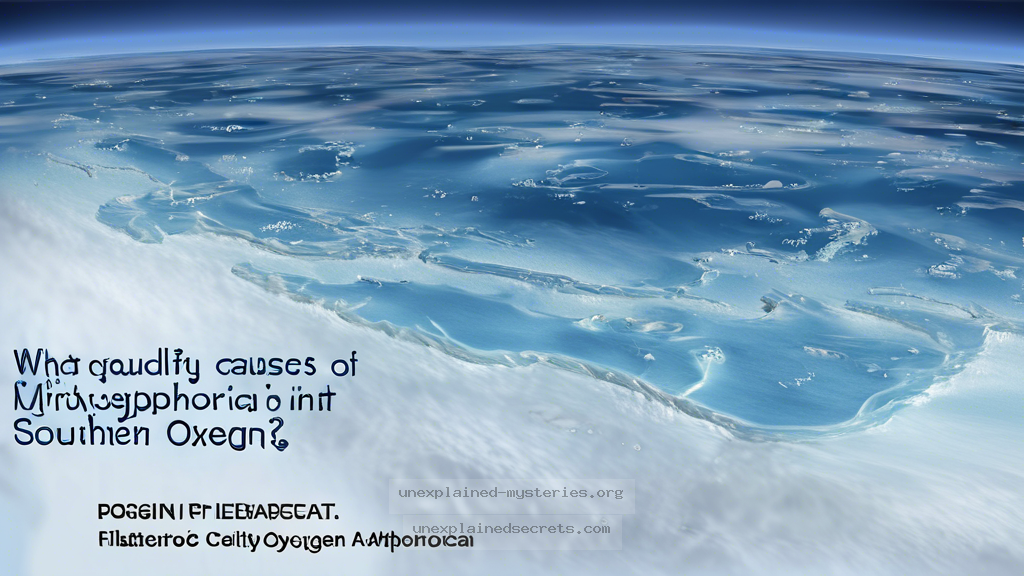What Causes the Mysterious Disappearance of Atmospheric Oxygen in the Southern Ocean?
What Causes the Mysterious Disappearance of Atmospheric Oxygen in the Southern Ocean?
The fluctuation of atmospheric oxygen levels is one of the most intriguing phenomena in Earth sciences, particularly in the context of climate change and oceanography. The Southern Ocean, known for its rich biodiversity and crucial role in global climate regulation, has recently been the focus of scientific inquiry due to a perplexing anomaly: a significant decline in dissolved oxygen levels. This question is not only important for understanding ocean health but also has broader implications for the planet’s climate systems, marine life, and even human activity. In this post, we will delve deep into this scientific mystery, exploring its historical context, core theories, practical implications, and much more.
Historical Context of Oxygen Levels in the Southern Ocean
Oxygen levels in oceans have been subject to natural variations throughout history, influenced primarily by factors such as temperature, salinity, and biological activity. However, the recent trend observed in the Southern Ocean is alarming. Historical data suggests that the ocean’s oxygen levels have been generally stable until the late 20th century. According to studies conducted by the National Oceanic and Atmospheric Administration (NOAA), there has been a documented decline of about 2% in the Southern Ocean’s oxygen levels since the 1970s.
This decline was first noted in the 1990s, when oceanographers began to utilize advanced technologies such as Argo floats and satellite observations, allowing for more precise measurements of oxygen levels across vast oceanic expanses. The implications of these findings were profound as they pointed toward potential disruptions in marine ecosystems, which rely on adequate oxygen levels for the survival of various species.
Core Concepts: Understanding Ocean Oxygen Dynamics
To grasp the mystery of disappearing oxygen, it is vital to understand the processes that govern oxygen dynamics in the ocean. Oxygen in ocean waters primarily comes from two sources: atmospheric diffusion and photosynthesis by marine phytoplankton. The Southern Ocean, rich in nutrient upwellings that stimulate phytoplankton growth, typically has higher levels of dissolved oxygen. However, as global temperatures rise, the solubility of oxygen in water decreases, leading to lower concentrations.
Another key factor is the stratification of ocean layers. Warmer surface waters form a barrier, preventing the mixing of oxygen-rich surface water with deeper layers. This stratification is exacerbated by climate change, causing a reduction in oxygen replenishment in deeper waters. As a result, the Southern Ocean is experiencing a double whammy: reduced oxygen input and increased stratification.
Practical Implications: Effects on Marine Life and Ecosystems
The decline in oxygen levels poses a significant threat to marine ecosystems. Species such as fish, crustaceans, and mollusks rely on adequate oxygen for survival. Hypoxia, or low oxygen conditions, can lead to “dead zones” where marine life cannot thrive. In the Southern Ocean, this is particularly concerning due to its unique biodiversity, including species that are found nowhere else on Earth.
Studies have shown that certain fish populations are already migrating towards the poles in search of oxygen-rich waters, potentially disrupting established ecosystems. Furthermore, the food web is at risk; if phytoplankton populations decline due to hypoxic conditions, it can have cascading effects throughout the marine food chain. This not only threatens biodiversity but also impacts fisheries and, consequently, human livelihoods dependent on these resources.
Alternative Perspectives: Debating Causes and Impacts
While the reduction of oxygen in the Southern Ocean has been widely attributed to climate change, some scientists argue that natural variability plays a significant role. For instance, ocean circulation patterns, influenced by wind and temperature changes, can also affect oxygen distribution. The Intergovernmental Panel on Climate Change (IPCC) acknowledges that multiple factors contribute to changes in ocean oxygen levels, and isolating the effects of anthropogenic climate change remains a complex challenge.
Furthermore, climate models often struggle to accurately predict local phenomena due to the intricacies of ocean dynamics. Some researchers argue that more localized studies are necessary to understand specific mechanisms at play in different regions of the Southern Ocean, as generalized models may overlook important variables.
Common Misconceptions and Clarifications
- Misconception: Oxygen depletion is only a problem in polluted areas.
- Clarification: Oxygen decline is occurring even in relatively pristine environments like the Southern Ocean, primarily due to climate change.
- Misconception: Only large marine species are affected by low oxygen levels.
- Clarification: All levels of the food web, including microscopic phytoplankton, are affected, which can alter entire ecosystems.
Best Practices for Investigation or Study
Investigating the decline in oxygen levels requires a multi-faceted approach. Here are some recommended practices for researchers:
- Longitudinal Studies: Continuous monitoring of oxygen levels using buoys and satellite technology can provide insights into long-term trends.
- Integrated Research: Collaborating with oceanographers, climatologists, and ecologists can yield a comprehensive understanding of the issue.
- Public Engagement: Raising awareness about the importance of ocean health is crucial for garnering support for conservation efforts.
Future Developments and Ongoing Research
As we look toward the future, several key areas of research are emerging. Scientists are developing advanced models to predict how various factors, including human activity and natural variability, will affect ocean oxygen levels. Research is also focused on finding innovative solutions for mitigating climate change, such as carbon capture technologies and restoration of marine ecosystems.
Additionally, international collaborations, such as the Southern Ocean Observing System (SOOS), aim to pool resources and knowledge to better understand the dynamics of the Southern Ocean and its role in global climate systems. These efforts are vital for informing policy decisions and conservation strategies.
Conclusion: The Urgency of Understanding Oceanic Oxygen Decline
The mysterious decline of atmospheric oxygen in the Southern Ocean is not merely an academic curiosity; it has profound implications for marine life, climate systems, and human societies. As we uncover the layers of this scientific anomaly, we gain valuable insights that are crucial for preserving ocean health and biodiversity. Understanding the interplay of natural and anthropogenic factors in this complex system is essential for creating effective strategies to mitigate the impacts of climate change.
As research continues to evolve, we must remain vigilant and proactive in our efforts to protect our oceans, ensuring that we not only understand the mysteries they hold but also take meaningful action to safeguard their future. 🌊💙
Other Articles
Recent Posts
- What Happened to Flight MH370? The Conspiracy Theories That Still Haunt Us
- What Secrets Lurk Within the Walls of the Infamous Trans-Allegheny Lunatic Asylum?
- What Evidence Supports the Existence of Bigfoot in the Pacific Northwest?
- What Happened to the Indus Valley Civilization? Unraveling the Mysteries of Ancient Urban Life
- Can Telepathy Be Scientifically Proven Through Laboratory Evidence?







